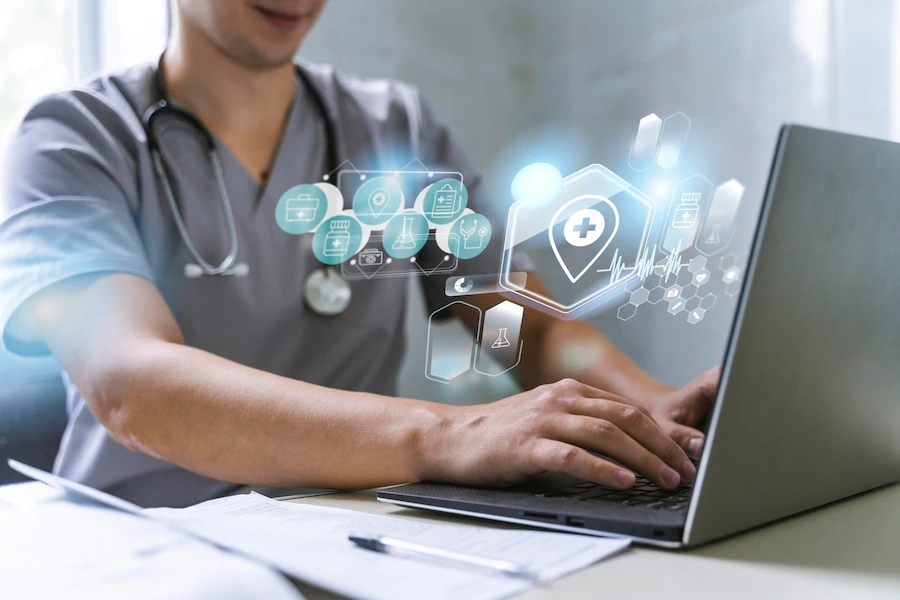Safeguarding Patient Data In The Digital Healthcare Era
With the increase in digitalization in all industries and aspects of daily life, it’s no wonder that healthcare is enjoying the efficiency and convenience that digitalization can offer. Technology has always aided healthcare in reaching remote locations, whether through the telegraph and telephone toward the end of the 19th century or today’s remote consultations with luminaries worldwide.
Remote healthcare is convenient for faraway regions or hard-to-reach locations and can be exceptionally useful when natural disasters strike or armed conflicts erupt. The internet has radically increased the availability of healthcare globally, and the need for remote care during the COVID-19 pandemic sped things along. Advanced healthcare has become more accessible, and new diagnostic tools have emerged, but this comes with an increased risk to data privacy.
Healthcare digitization now involves employing numerous electronic devices, from computers to laptops to tablets to smartphones,, monitoring devices, wheelchairs, vehicles, and more. Huge amounts of data are collected and stored to create a patient’s medical record, channeled to various devices as needed.
While this has improved healthcare and its availability a hundredfold, security challenges have also increased regarding safeguarding patient data and the threat of improper utilization of tracking technology. New technology can expose sensitive data and violate patients’ rights to privacy. Finding the right security platform that responds to the specific needs of healthcare organizations is crucial to secure healthcare management.
Contents
Digital Healthcare Tools For Protecting Patient Data
![]()
Digitalization has not only brought about tremendous opportunities for healthcare but thanks to technological advances, new security technology has also been developed, offering cutting-edge tools for protecting sensitive data.
Identity And Access Management
Creating an identity and access management infrastructure is critical when defending sensitive patient data. An IAM system will permit all stakeholders, including patients, doctors, employees, and administrators, to login into healthcare data systems with specific limited access permission depending on the user. Users should only have the access they need. Often, data breaches are due to internal theft or simple human error. Unlimited access to an entire system should never be granted.
Digital access management also offers scalability, which looks to the future, allowing for growth, mergers, or the integration of new information, diagnostic tools, and more.
Physical Security
Restricting physical access to locations where patient data is stored is essential to protecting information. This kind of access limitation includes using physical access control technologies, such as commercial door locks, for specific areas and workstations. Physical security is equally important to cybersecurity strategies and controls. Determining which workstations can access patient health information and limiting who can access these stations will offer patient data protection.
Zero Trust Security Protocol
With so many medical and electronic devices connected to the internet and doctors and patients communicating remotely using apps, chats, and platforms, single platform or perimeter security is no longer viable.
Many healthcare processes now take place outside one network’s boundaries as data is collected and stored in various storage locations and gathered using both hospital and personal devices. Sensitive data is now distributed using more than just a single network.
Each device and digital health service must be protected regardless of whether internal or external. Creating a Zero Trust Architecture for system access is one way to ensure who is accessing information is properly authorized. Zero Trust is based on the premise that every device and every user needs to be authenticated at every login.
Mobile Device Management Software
Additional endpoints created using numerous mobile devices increase security concerns. The employment of Mobile Device Management software will permit administrators and IT cybersecurity personnel to monitor mobile devices. MDM software also furnishes cybersecurity tools such as erasing sensitive data from stolen or lost devices.
Multi-Factor Authentication
The remote use of computers, tablets, and smartphones has also increased the threat of cyberattacks. MFA or multi-factor authentication should be a requirement. MFA using two or more authentication methods will add extra protection for patient data and employees that bad actors may eventually target.
Encryption
Stored data is often encrypted, but transiting data also needs to be encrypted. When patient health information is encrypted, even if it is intercepted, it cannot be accessed if the hacker or bad actor does not have the encryption key. Only top IT security personnel should have the ability to modify an organization’s encryption status.
Employee Training
One of the best things any healthcare organization can do is educate employees on how to avoid security breaches and recognize potential threats and attacks. Training should be updated and repeated regularly to establish a cybersecurity culture within the organization. Many attacks center on human error and behavior.
In Conclusion
Protecting patient health information is necessary for any type of healthcare entity. Aside from laws and regulations requiring protection, the organization should enact security strategies, protocols, and best practices in the interest.
Safeguarding patient data in the digital healthcare era means using new technological security tools to protect sensitive data from the significant risks of bad actors. Data theft or loss can devastate healthcare companies and institutions in reputational and financial terms. Reliable IT digital security strategies will permit healthcare entities to perfect remote healthcare services and protect patient data while doing so.
Read Also:
- Helpful Tips to Improve your Posture and Reduce Back Pain
- 3 Things To Consider Before Getting Liposuction
- How To Start A Private Therapy Practice



